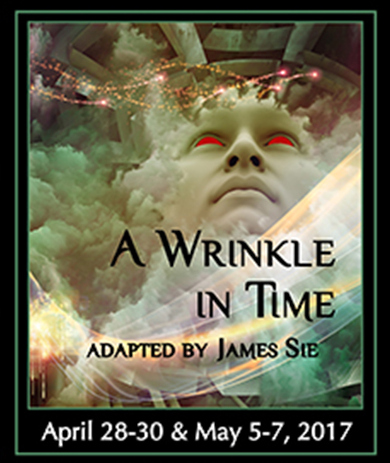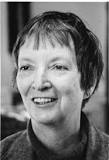A Wrinkle in Time: Dramaturgy

This blog was created in 2013 to serve as a repository of all the information we can’t cram in a page or two of the printed program. In this case, there is so much information readily available online about this book, we are choosing to limit our writing to a brief biography of L’Engle and a synopsis of the beginning of the book, along with some notes on our staging. After the play opens on April 28, we may include more production notes along with photos.
Here then is an only-slightly-expanded version of the Dramaturgy you will find in our program. Those of you who will attend get a chance to read it ahead of time, and in better light.
—- . —- . —- . —- . —- . —- . —- . —- . —- . —-
A brief author biography:

Educated in American and Europe, and holding a degree from Smith College, L’Engle began her career writing novels in New York City while working in theater. She met her husband, Hugh Franklin while understudying a role in The Cherry Orchard. They married in 1946 and had two children, Josephine and Bion, later adopting Maria, the orphaned daughter of friends. In 1952 the family moved to a 200-year-old farmhouse in Connecticut, where they resurrected and ran a general store. Madeleine continued to write, though she was not making significant money at it.

L’Engle went on to write four more sci-fi/fantasy books about members of the Murray and O’Keefe families (see synopsis below). Two of them won Newbery honors, a “runner up” prize in the Newbery competition. Her other young adult novels intersect these families’ lives, as well, though they more ‘realistic’ books.
Hugh Franklin died of cancer in 1986, and L’Engle wrote her memoir, Two-Part Invention, as a tribute to their happy forty-year marriage. L’Engle, a devout Anglican Christian, was a frequent lecturer and seminar leader on matters of faith and art until ill health prevented further travel or speaking around 2001. She died of natural causes just before her 89th birthday in 2007.
The story of A Wrinkle in Time begins:
Meg Murray, age 12, feels like a misfit at home and at school. Her beautiful and brilliant mother is a scientist. Her father, also a research scientist, has been away on a top-secret government project for so long that people are beginning to speculate that he has actually abandoned his family. Meg has 10-year-old twin brothers who play little part in this book (although they are featured in later stories about this family, which make up what is now called The Time Quintet). The youngest Murray sibling, Charles Wallace, is five, a genius and possesses a strong empathy for Meg which borders on mind-reading.
In the story’s opening chapter, Meg, Charles Wallace and Mrs. Murray are visited in the middle of a stormy night by Mrs. Whatsit, an eccentric and mysterious woman who implies she knows something about the missing Mr. Murray. In short order, Meg is introduced to Calvin O’Keefe, a boy several years ahead of her in school, as well as two friends of Mrs. Whatsit: Mrs. Which and Mrs. Who. With little warning, the three children are whisked away to another galaxy on a quest to find and save Mr. Murray, who has been imprisoned on a “dark planet”. Throughout the story, themes of darkness and light are used to underscore the battle to rescue Mr. Murray—and perhaps their own planet—from It, a mind-controlling being who has enslaved all of the planet Camazotz.
OK, no more spoilers. It is easy enough to find the full synopsis elsewhere online.
Bringing A Wrinkle in Time to life:
It is interesting to note that this book, continuously in print since its first publication, was not ever brought to the stage until this adaptation by James Sie, written in the late 1990s for Lifeline Theater in Chicago. Two other stage adaptations, by John Glore and Tracy Young, have been written since 2010. The book was made into a TV movie in 2003. (L’Engle, when asked about it, said, “I expected it to be bad, and it is.”) Walt Disney Pictures is currently in production of a new live feature film version which is scheduled for release in 2018.
The sheer scope of the story, which travels to multiple planets, includes three young protagonists, and references so many classical quotations (many in foreign languages), not to mention its religious themes, make it a daunting project to bring to stage or screen. Modern special effects and computer technology solves some of these problems on film, but not necessarily onstage.
In designing this production, guest director/production designer Jeff Salisbury (afO’s technical director and lighting designer) has taken a balanced approach between technical “magic” and theatricality. Our stark alley-style staging with very little by way of set or furniture, will allow the audience to use their imagination to create the landscapes of planets. Special care has been taken with lighting, sound effects creation, and video animation, to suggest some of the more unusual pieces of the story, including the space/time travel called “tessering” and the mind-controlling rhythms of IT. We hope you enjoy it!
